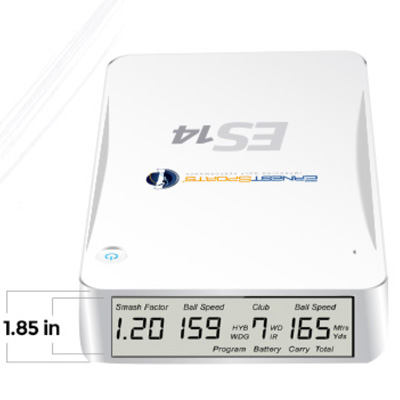2014 brought Ernest Sports’ latest portable launch monitor, the ES14. As with the prior generation ES12 (launched in ’12), the ES14’s strongest selling point might be it’s ease of setup relative to other high-end options, and, at 8.25″ x 5.5″ x 1.85″ and 3.5 pounds, portability.
To get started, users need to simply bring the ES14 to the range (or to their home golf studio), adjust the integrated kickstand to make sure the device is angled appropriately to capture ball speed information (you’ll need to adjust the kickstand depending on the group of club you are using: driver to 5-iron, 6-iron to gap wedge, and lob and sand wedge), and power up the device. The ES14 operates on a 9V battery (there is a battery well for storing an additional battery within the case), so you don’t even have to worry about toting your power adapter, though that is an option if desired.
Before starting you’ll want to check the default settings on the device to adjust for altitude and your club loft angles, and, before swinging away, tell the ES14 what club you are using – more on these later. We’ll be quick to note that the ES14 is placed 14″ in front of your ball position (toward the target) and 14″ to the side (away from the player), so if you are prone to the shanks, think twice before purchasing!
The ES14 uses doppler radar to instantly measure club speed and ball speed, and then from this information additionally calculates smash factor, launch angle, spin rates and distance. Information displayed on the LCD on the top of the device, in addition to the club in use, are:
Screen 1: smash factor, club speed, ball speed
Screen 2: spin, carry distance, total distance
To receive additional information, such as launch angle, you’ll need to pair your ES14 via Bluetooth to your mobile device and use the free ES14 app. In addition to allowing you to access launch angle, the app allows you to start a new range session or join a previously saved session, view data from previous sessions, view averages from all clubs, and change settings.
The biggest gripe that players will have is that the ES14 doesn’t directly measure some of the metrics available that high-end devices can (and by high-end we are talking about those in the thousands of dollars). For example, the launch angle, spin, and distance readings are calculated based off of club and ball speed readings on the ES14. So while Ernest Sports looks to move upmarket, this may be one of the limiting factors in competing with the next tier of launch monitors.
Many players, however, will find these calculated results, based on lots of testing by Ernest Sports, more than good enough for their needs. The ES14 offers the basics to the player, and adds some of the data that has been lacking to date in all but the most expensive portable launch monitors. The ES14 is easy to set up, though there is a bit of work to select club information while practicing, along with the risk of breakage from a shanked shot, considerations that you might not need to deal with for other launch monitors.
For those players who are content with only ball and club speed could consider the older ES12 or the Voice Caddie SC100. For those players demanding devices that provide more measured distances, and arguably greater accuracy, get ready to break out your wallet for the next tier of devices such as the FlightScope X2, ForeSight GC2, Zelocity, or the TrackMan.
The ES14 is available in white and charcoal, and carries a 12-month warranty.
Retail price: $549.99
Amazon.com: Check price now


